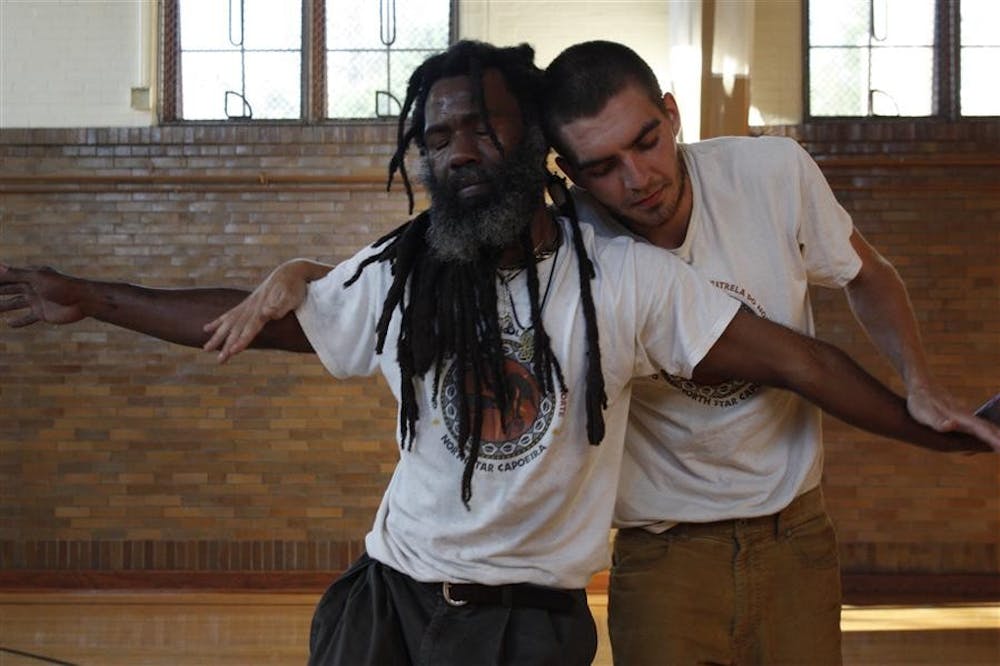On a Monday night at the Harmony School, nestled into Bloomington’s residential Second Street, quiet passersby can hear the thick drum beats of music from far-away Brazil.
And if they wandered into the little brick building from which it came, they would find a small group of people practicing one of Brazil’s oldest traditions: Capoeira Angola.
A combination of combat, dance and music, Capoeira Angola features two “players” surrounded by a semi-circle and eight instrumentalists to which the players perform.
The interaction between the players, musicians and observers in Capoeira Angola is considered a martial art, but it incorporates elements of dance with fluid, graceful body movements. Early teachers of Capoeira used the movements of animals to influence their fighting style.
“The masters learned by watching the animals and building their movements like that,” said Iuri H. Santos, founder of North Star Capoeira Group and teacher of Capoeira at the School of Health, Physical Education and Recreation. “You can see – the players move like crabs, going sideways and walking backwards. Or when you watch their kicks, like the tail of a sting ray.”
Santos was born in Bahia, Brazil, where he started studying Capoeira at age 14.
In 1998 he met his wife, Linda Lewis, who teaches at Harmony School, while she was studying Portuguese in Brazil.
They were married there, and he has now been the Mestre, or leader, of the North Star Group in Bloomington for more than 10 years.
North Star Capoeira Group has members in Bloomington, Indianapolis, Evansville and Georgetown, Texas.
“I’ve been training with Iuri in Bloomington since 2004,” said Paul Swanson, North Star Treasurer and teacher at Harmony School. “I have taught children’s Capoeira classes and have grown to think about the group as family.”
Swanson continues to dedicate a significant part of his life to practicing Capoeira.
The summer after he came to Bloomington, he lived in Salvador, the capital of the Brazilian state of Bahia, where North Star Mestre Santos is from. There he worked out and practiced percussion in the mornings, played the guitar and learned Portuguese in the afternoons, and practiced Jiujitsu and Capoeira with Santos’ teacher, Mestre Marrom, in the evenings.
“For me, Capoeira is not about learning how to fight, staying in shape or even learning an art from a different culture, although it is all those things,” said Swanson. “For me, Capoeira is a part of who I am and who I am becoming, and without it there is something missing.”
Similar to many players, Swanson said he was first attracted to Capoeira by its ability to combine music and martial arts.
Music is a crucial element in Capoeira Angola, as players respond not only to each other, but also to the music being played to them. The rhythm of the music determines the type of game that the players will engage in.
Some rhythms call for slower, less interactive games, and others for closer proximity and more contact.
“In Capoeira Angola, you can’t separate the dance of the martial art or the martial art of the dance,” Santos said. “It all happens together.
“When we do the Capoeira circle, players have to know the music and the songs because the songs are like the bookkeeper of Capoeira – they tell the players to play in this way or that way. They move in response to the music.”
Similar to the rhythms, the lyrics in the songs of Capoeira are vital to the art form.
“The songs are talking about the history of Capoeira and of slavery through generations,” Santos said. “Capoeira is not supposed to be aggressive. The players are supposed to interact with each other without even touching sometimes, but the danger is there. That doesn’t mean they can’t fight or hurt each other, but that’s the beauty of Capoeira. That’s what makes it different from other
martial arts.”
Another element that sets Capoeira apart is its philosophy.
The art form evolved from slaves brought to Brazil from Africa, looking to defend themselves from violent overlords.
The recreational nature of Capoeira, with its elements of song, dance and tradition of limited contact, allowed slaves to disguise their self-defense training as leisure or amusement.
“The philosophy of Capoeira encourages people to always be playful, yet remain wary of those who might wish you harm,” said Lauren Miller, North Star member and IU anthropology graduate student researching Capoeira for her dissertation. “It is a philosophy that grew out of slaves’ experiences in Brazil but remains applicable to life today.
“If you spend enough time practicing any art or sport, it will change the way you view the world, and this is certainly true of Capoeira.”
WANT TO SEE NORTH STAR PERFORM?
WHEN 3 p.m. Saturday
WHERE HPER Martial Arts Fest in HPER Gym 199
MORE INFO The Martial Arts Fest includes additional performances and takes place from 1 to 5 p.m.
Capoeira: An infusion of dance & martial arts

Get stories like this in your inbox
Subscribe





